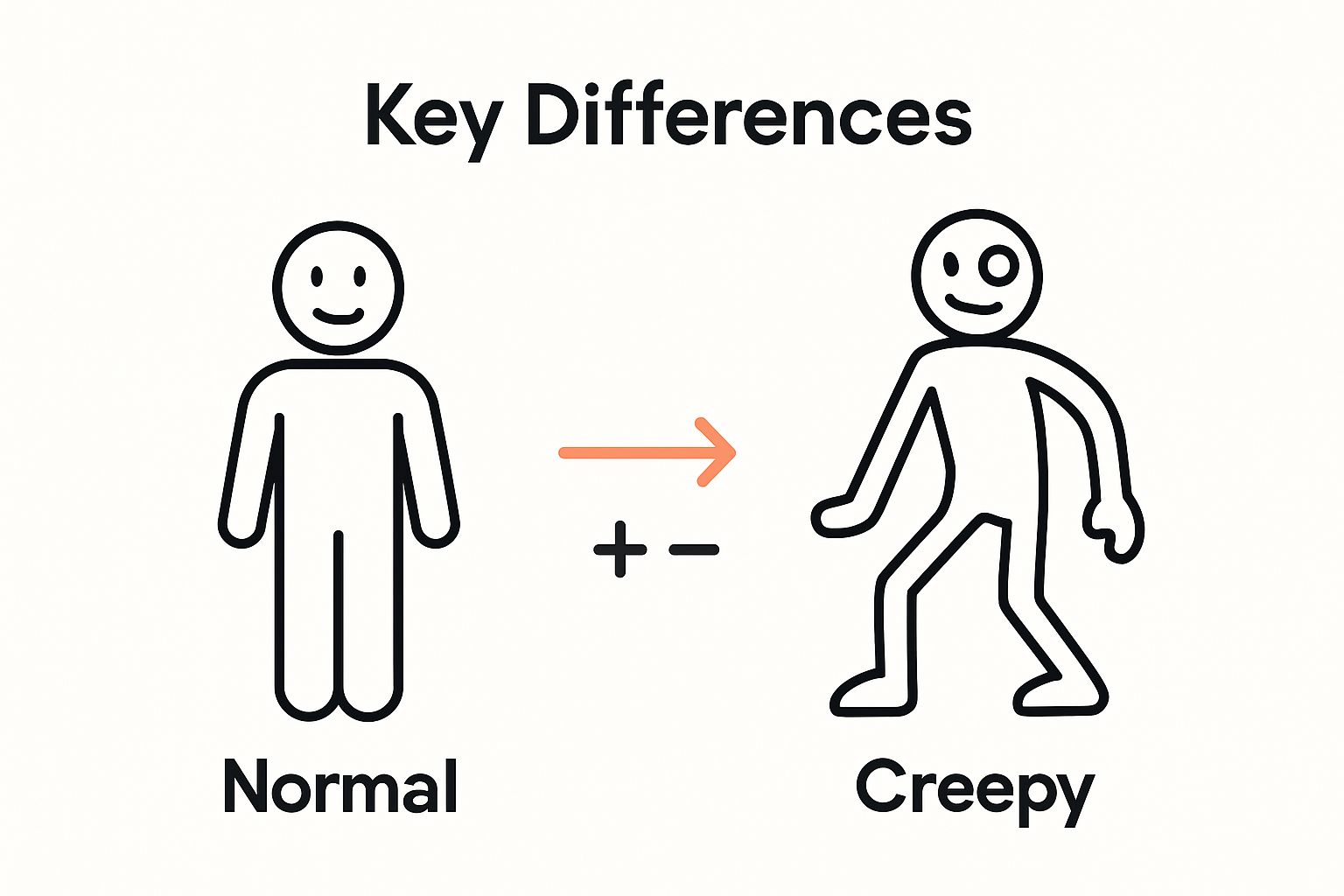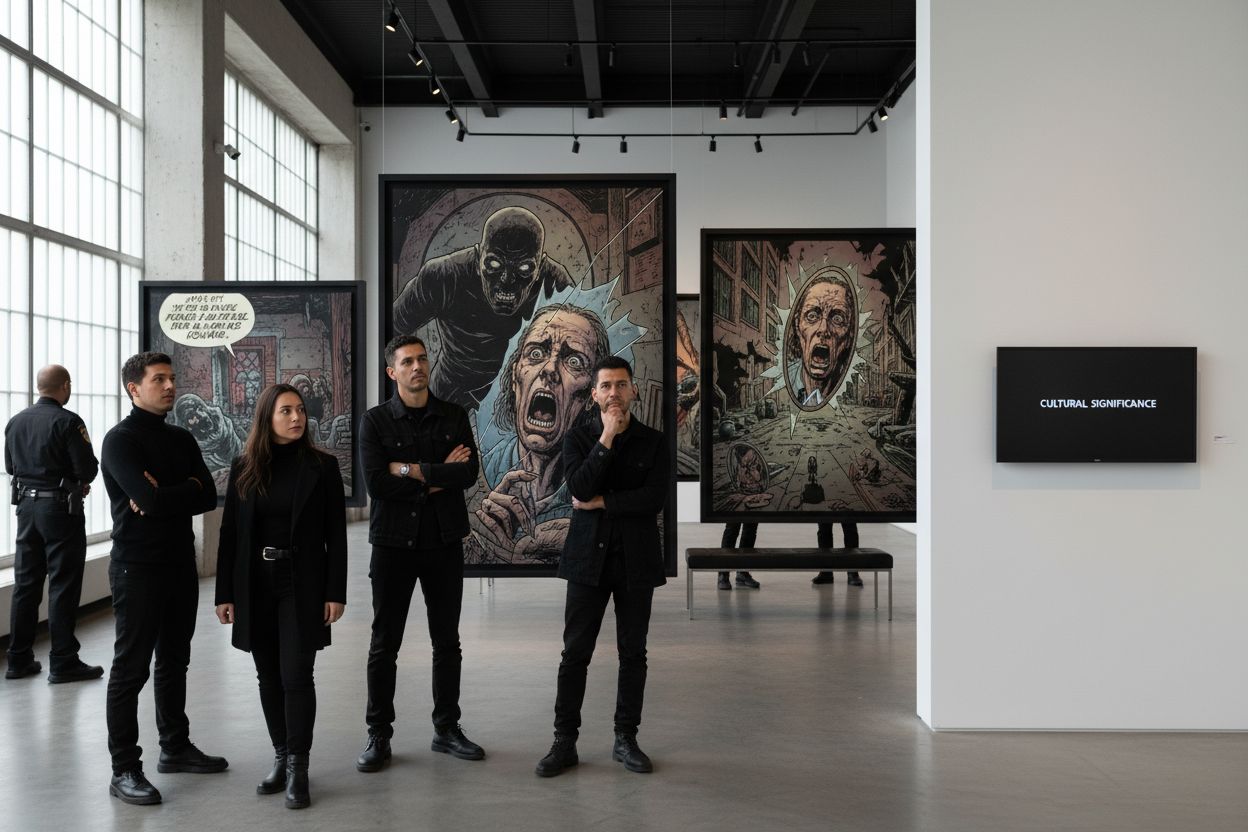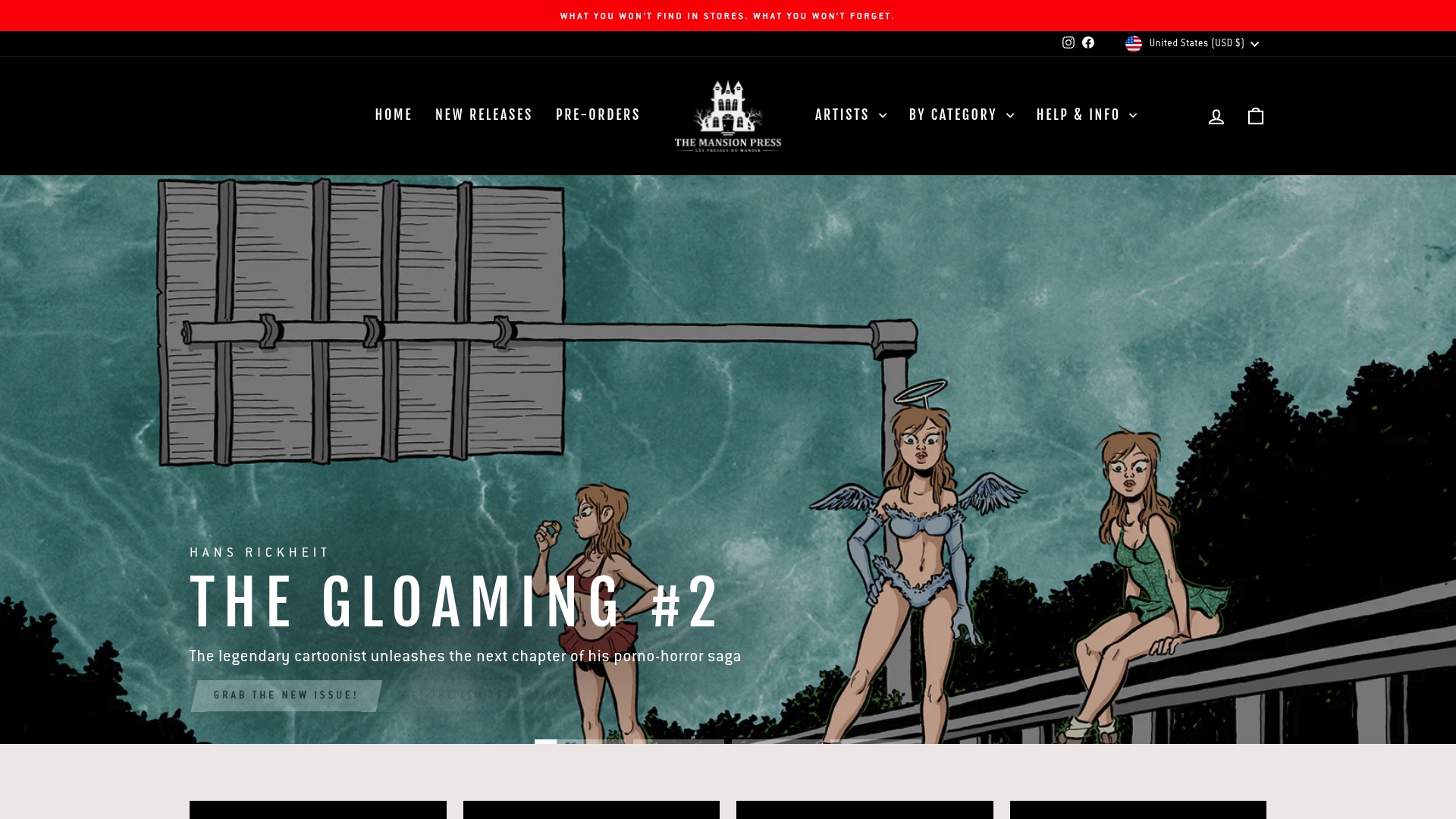Understanding Creepy Comic Book Imagery and Its Impact
Creepy comic book imagery flips normal storytelling on its head. You might expect a splash of fake blood or a few twisted faces, but some artists take it way further. A single distorted panel can actually trigger measurable changes in your brain, including increased heart rate and heightened alertness, according to Stanford research. So the real surprise is not about what you see on the page, but how those images get under your skin and stick with you long after you turn the page.
Table of Contents
- Defining Creepy Comic Book Imagery: Key Characteristics
- The Psychological Impact Of Creepy Imagery In Comics
- Artistic Techniques Used In Creepy Comic Book Imagery
- Cultural Significance And Evolution Of Creepy Comics
- Creepy Comic Imagery In Contemporary Art And Media
Quick Summary
| Takeaway | Explanation |
|---|---|
| Creepy imagery violates visual norms. | The genre distorts familiar human forms to create unsettling visuals that challenge viewers’ expectations. |
| Psychological impact triggers fear responses. | Creepy visuals activate threat detection in the brain, provoking strong physiological reactions such as increased heart rate. |
| Digital techniques enhance creepy comic artistry. | Contemporary artists use technology to create immersive experiences that blend traditional and digital storytelling methods. |
| Creepy comics serve as social commentary. | They reflect societal fears and anxieties, exploring themes of identity, vulnerability, and cultural tensions. |
Defining Creepy Comic Book Imagery: Key Characteristics
Creepy comic book imagery represents a complex visual language that transcends traditional storytelling boundaries, creating psychological tension through strategic visual manipulation. This genre of visual art deliberately challenges viewers’ comfort zones by introducing unsettling elements that provoke deep emotional responses.
Visual Disruption of Normal Expectations
The core of creepy comic book imagery lies in its ability to violate fundamental visual expectations. Artists achieve this by distorting familiar human forms, introducing unexpected anatomical modifications, or creating visual scenarios that defy logical perception. Research from the University of Chicago suggests that such imagery operates by exploiting the psychological concept of the “uncanny” - where something appears simultaneously familiar and profoundly alien.
Key techniques in creating creepy comic book imagery include:
- Exaggerating human proportions beyond natural limits
- Introducing asymmetrical or impossible bodily configurations
- Manipulating facial expressions to suggest internal psychological distress
Psychological Mechanisms of Visual Discomfort
Creepy comic book imagery works by triggering fundamental human psychological responses. It strategically attacks viewers’ innate sense of safety and predictability by presenting visual narratives that challenge cognitive processing. The most effective creepy imagery doesn’t just shock but creates a lingering sense of unease that persists even after viewing.
Artists often employ subtle techniques like unnatural color palettes, shadowing that defies light sources, and character designs that blur boundaries between human and inhuman forms. Check out our guide on understanding psychological horror comics for deeper insights into these mechanisms.
Ultimately, creepy comic book imagery is a sophisticated visual language that communicates complex emotional states through deliberate visual disruption, inviting viewers into a realm where normative perceptions are perpetually questioned and challenged.
The Psychological Impact of Creepy Imagery in Comics
Creepy comic book imagery operates as a powerful psychological instrument, engaging complex neural and emotional mechanisms that extend far beyond simple visual consumption. By deliberately manipulating cognitive and emotional responses, these visual narratives create profound psychological experiences that challenge viewers’ fundamental perceptions of safety and reality.
Neurological Trigger Mechanisms
The human brain processes creepy imagery through intricate neurological pathways that activate threat detection systems. Psychological research from Stanford University reveals that such imagery stimulates the amygdala, the brain region responsible for processing fear and emotional responses. When viewers encounter unsettling visual representations, their neurological systems instantaneously generate physiological reactions such as increased heart rate, heightened alertness, and subtle stress responses.
Key neurological responses triggered by creepy comic imagery include:
- Rapid activation of the sympathetic nervous system
- Increased cortisol production signaling potential threat
- Heightened sensory processing and vigilance
Emotional Processing and Psychological Defense
Creepy comic book imagery engages sophisticated emotional processing mechanisms. Rather than simply frightening viewers, these visual narratives create complex emotional landscapes that invite psychological exploration. Artists strategically construct images that hover between familiar and unfamiliar territories, compelling viewers to confront their internal psychological boundaries.
Explore our guide on understanding inspiration from horror comics to delve deeper into these intricate emotional landscapes. The most compelling creepy imagery does not merely shock but invites viewers into a nuanced psychological dialogue about fear, perception, and human vulnerability.
Ultimately, creepy comic book imagery represents a sophisticated psychological technology that transforms visual consumption into a deeply introspective experience, challenging viewers to examine their own emotional landscapes and psychological resilience.
Artistic Techniques Used in Creepy Comic Book Imagery
Creepy comic book imagery represents a sophisticated artistic discipline where visual storytelling transcends traditional narrative boundaries. Artists employ intricate techniques that transform simple illustrations into profound psychological experiences, strategically manipulating visual elements to evoke complex emotional responses.
Visual Distortion and Anatomical Manipulation
Anatomical disruption serves as a primary mechanism for creating unsettling visual narratives. Artists deliberately subvert natural human proportions, introducing subtle yet profoundly disturbing modifications that challenge viewers’ fundamental understanding of bodily integrity. Research from the Art Institute of Chicago reveals that successful creepy imagery operates through strategic visual destabilization.
Key anatomical manipulation techniques include:

- Elongating human limbs beyond natural proportions
- Creating impossible skeletal configurations
- Introducing asymmetrical facial features that defy biological symmetry
Lighting and Compositional Strategies
Lighting plays a crucial role in generating psychological tension within creepy comic book imagery. Artists meticulously employ chiaroscuro techniques, using extreme contrast between light and shadow to create visual uncertainty. These techniques transform ordinary scenes into landscapes of potential threat, where darkness becomes a character itself.
Check out our guide on creating horror comics techniques for deeper insights into these sophisticated visual strategies. Composition becomes a psychological weapon, with panel layouts designed to disorient and destabilize viewers’ visual expectations.
Below is a table summarizing the artistic techniques used to create unsettling and creepy comic book imagery, with examples of how each technique is described in the article.
| Artistic Technique | Description/Effect | Example from Article |
|---|---|---|
| Anatomical Manipulation | Distortion of human bodies to challenge normal perception | Elongating limbs, impossible skeletal configurations |
| Asymmetrical Features | Creating unbalanced elements that defy biological symmetry | Asymmetrical facial features |
| Lighting (Chiaroscuro) | Use of extreme contrast between light and shadow | Shadowing that defies light sources |
| Unnatural Color Palettes | Employing color schemes outside normal expectations | Unnatural colors to enhance discomfort |
| Disorienting Composition | Structuring panels to disorient and destabilize viewer expectation | Panel layouts that destabilize viewers’ visual expectations |
| Human-Inhuman Blurring | Mixing human features with alien or inhuman elements | Designs that blur boundaries between human and inhuman |
Ultimately, creepy comic book imagery emerges as a nuanced artistic language where technical skill meets psychological manipulation, inviting viewers into a realm where visual representation becomes a profound exploration of human vulnerability and perception.
Cultural Significance and Evolution of Creepy Comics
Creepy comic book imagery represents more than a narrative technique it is a profound cultural artifact that reflects societal fears, psychological landscapes, and transformative artistic expressions. These visual narratives serve as complex social documents, capturing collective anxieties and challenging established perceptual boundaries across different historical periods.
Historical Transformation and Social Commentary
The evolution of creepy comics is intrinsically linked to broader cultural shifts and societal psychological dynamics. Comic book horror genres emerged as powerful platforms for social critique, using unsettling visual metaphors to communicate complex emotional and political narratives. According to the Smithsonian Magazine, these comics frequently challenged social norms by exposing underlying cultural tensions and unspoken psychological dynamics.
Significant historical milestones in creepy comic book evolution include:
- Emergence of underground horror comics in post-World War II America
- Challenges to mainstream censorship through provocative visual storytelling
- Integration of psychological complexity into graphic narrative forms
Transgressive Artistic Expression
Creepy comic books function as a transgressive artistic medium, providing creators with unique opportunities to explore human vulnerability, social taboos, and psychological boundaries. Artists use this genre to deconstruct traditional narrative structures, challenging viewers to confront uncomfortable psychological territories.
Discover our curated list of strange comics that push creative boundaries for a deeper understanding of these innovative artistic expressions. The most compelling creepy comics transcend mere shock value, offering nuanced explorations of human complexity and societal introspection.

Ultimately, creepy comic book imagery represents a sophisticated cultural technology that transforms visual storytelling into a profound mechanism for understanding human psychology, social dynamics, and the complex emotional landscapes that shape our collective consciousness.
This table compares the psychological and cultural roles creepy comic book imagery plays, highlighting their impact on individuals and society reflected throughout the article content.
| Dimension | Description | Example from Article |
|---|---|---|
| Psychological Impact | Triggers threat detection, increased heart rate, and alertness | Fear responses, amygdala activation, heightened alertness |
| Emotional Processing | Creates complex emotional landscapes and introspection | Viewers confront vulnerability, discomfort, and internal boundaries |
| Social Commentary | Reflects societal fears and critiques cultural norms | Cultural anxieties, social tension, challenges to mainstream censorship |
| Artistic Transgression | Pushes boundaries of visual norms and narrative structures | Exploration of taboos, deconstructing traditional storytelling |
| Contemporary Expansion | Extends into digital and multimedia formats | Digital rendering, interactive media, transmedia storytelling |
Creepy Comic Imagery in Contemporary Art and Media
Contemporary art and media have transformed creepy comic book imagery from a niche genre into a powerful interdisciplinary narrative technique. This evolution reflects increasingly sophisticated approaches to visual storytelling, where psychological complexity and visual disruption merge across multiple creative platforms.
Digital Transformation and Multimedia Expansion
Digital technologies have radically expanded the potential of creepy comic imagery, enabling artists to create increasingly immersive and psychologically complex visual experiences. Artists now leverage sophisticated digital manipulation techniques to blur boundaries between traditional comic illustration, animation, and interactive media. Contemporary art research indicates that these technological advancements allow for unprecedented levels of visual complexity and emotional manipulation.
Key contemporary manifestations of creepy comic imagery include:
- Transmedia storytelling across graphic novels, video games, and interactive digital platforms
- Advanced digital rendering techniques that create hyper-realistic unsettling visuals
- Hybrid narrative forms combining traditional comic aesthetics with experimental multimedia approaches
Psychological Representation and Social Critique
Contemporary creepy comic imagery has evolved beyond pure aesthetic shock, emerging as a sophisticated medium for psychological and social commentary. Artists use these visual techniques to explore complex themes of identity, alienation, technological anxiety, and human vulnerability.
Explore our in-depth guide on understanding body horror in comics to gain deeper insights into these nuanced representations. The most compelling contemporary works transform creepy imagery from a genre into a profound philosophical and emotional exploration.
Ultimately, creepy comic book imagery in contemporary art represents a dynamic, evolving language of visual communication, continually pushing the boundaries of how we perceive, interpret, and emotionally engage with complex narrative experiences.
Experience the Art of Creepy Imagery Up Close: Collect What Moves You
Are you fascinated by how creepy comic book imagery can challenge your perceptions and leave a powerful emotional impact? If the article resonated with your curiosity about visual disruption, psychological tension, or the evolution of unsettling comic art, you are not alone. Many art lovers and collectors crave access to rare, boundary-pushing works but struggle to find authentic editions that capture the intensity described in our exploration of distorted anatomy, eerie lighting, and transgressive storytelling.

Discover the exclusive selection at The Mansion Press where you can find original artbooks, limited edition comics, and collector’s pieces directly from independent artists who master the craft of unsettling, intriguing visuals. Now is the perfect time to act if you want to own a piece that truly embodies the impact and artistry of creepy comic imagery. Ready to bring these unique works into your collection? Begin browsing or pre-order your next standout title at The Mansion Press online store and unlock access to more thought-provoking inspirations. For a deeper understanding of these creative approaches, see how we support artist showcases and rare comic collaborations, connecting you with the heart of the genre.
Frequently Asked Questions
What are the key characteristics of creepy comic book imagery?
Creepy comic book imagery is defined by visual disruptions that challenge expectations through anatomical distortions, unsettling scenarios, and the manipulation of light and shadow. To recognize these characteristics, examine comic panels for exaggerated features and unexpected visual configurations.
How does psychological discomfort play a role in creepy comic book imagery?
Psychological discomfort is a central element in creepy comic imagery, designed to evoke emotional responses and challenge viewers’ perceptions of safety. To explore this aspect, read a variety of creepy comics and note how different imagery affects your emotional state.
What artistic techniques are commonly used in creating creepy comic book imagery?
Artists use techniques like anatomical manipulation, chiaroscuro lighting, and unconventional composition to create unsettling visual experiences. Analyze specific panels in your favorite creepy comics to see how these techniques are employed.
How has the evolution of creepy comic book imagery influenced contemporary art?
The evolution of creepy comic book imagery has expanded into digital and multimedia platforms, allowing for richer storytelling and visual complexity. Explore contemporary examples by following new releases in graphic novels and digital art that push these boundaries.
In what ways does creepy comic book imagery serve as social commentary?
Creepy comic book imagery often reflects societal fears and critiques cultural norms through unsettling narratives. To better appreciate this aspect, consider the historical context of the comics you’re reading and how they may relate to current social issues.
Recommended
- Understanding Inspiration from Horror Comics: A Deep Dive – The Mansion Press
- Understanding Psychological Horror Comics: Themes and Impact – The Mansion Press
- 7 Disturbing Comics List: Must-Reads for Fans – The Mansion Press
- Creating Horror Comics Tips: Capture Fear in Illustrations – The Mansion Press

